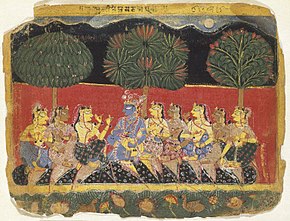Gopi (mythology)


As Gopīs (गोपी) or Gopikās (गोपिका) cowherd women were called in India; together with the god Krishna they play a not insignificant role in Hindu mythology and Hindu art.
etymology
The terms gopī (गोपी) and gopikā (गोपिका) come from Sanskrit and represent the feminine version of the words gopa (गोप) or gopaka (गोपक) "cowherd" ( go = "cow", -pa (ka) = " guarding ”; gopa (ka) “ one who watches over the cows ”) and therefore means something like“ cow girl ”or“ cowherdess ”. The term can refer to the cowherdess as well as the wife of a cowherd.
history
One of the traditions in the rural areas of India was the grazing of cattle, which had to be done under supervision until harvest, as free-range cattle, sheep and goats would have eaten the farmers' fields. The herding of the animals was the work of boys ( gopalas ) and girls ( gopikās ) between the ages of 10 and 16, who were always separated according to sex; both groups had to be nimble and alert, as the animals quickly escaped their care. While watering the animals by the river, the girls sometimes took a bath, taking off their only item of clothing - a long length of fabric ( saree ), which gave the boys in the village the opportunity to secretly observe.
mythology
These primal experiences of rural life have also entered the mythology of the Hindus and play a major role in the tenth book of Bhagavatapurana in the stories of the god Krishna. This - still a shepherd boy himself - took the saris of the Gopīs and climbed a tree with them; so the girls had to appear before him undressed and ask him to hand them over. Every child in India knows this legend; Since the 16th century she has been depicted innumerable times on miniature paintings - mostly in a very chaste manner. In contrast, it does not appear in classical Indian sculpture. One of the gopīs, Radha , became Krishna's most important companion - both are often represented together (sometimes even as one person).
As an adult, Krishna drives the women of the village to a frenzy by playing the flute at night; they neglect their domestic duties, leave everything behind and have fun with him in the forest of Vrindavan .
symbolism
The rather relaxed and joking, but sometimes tense and painful relationship between Krishna and the Gopīs (especially Radha) is considered to be one of the archetypes of earthly, but also divine love ( bhakti ): the love of a god belongs to all people equally, during devotion of a person is usually only given to one god.
- “ The essence of true surrender ... causes goosebumps, tears, loss of self-control and frenzy. Those who truly love the Lord behave like the gopis . They don't let anything step between themselves and the Lord ... In their indifference to normal social roles, in their extreme upsurge of emotions and madness, the gopis serve as a fitting parable for the divine-human love story. "
See also
literature
- David Kinsley: Indian Goddesses. Female deities in Hinduism. Insel, Frankfurt / M. 1990, pp. 118ff, ISBN 3-458-16118-X
Web links
Individual evidence
- ↑ David Kinsley: Indian Goddesses. Female deities in Hinduism. Insel, Frankfurt / M. 1990, p. 120, ISBN 3-458-16118-X

